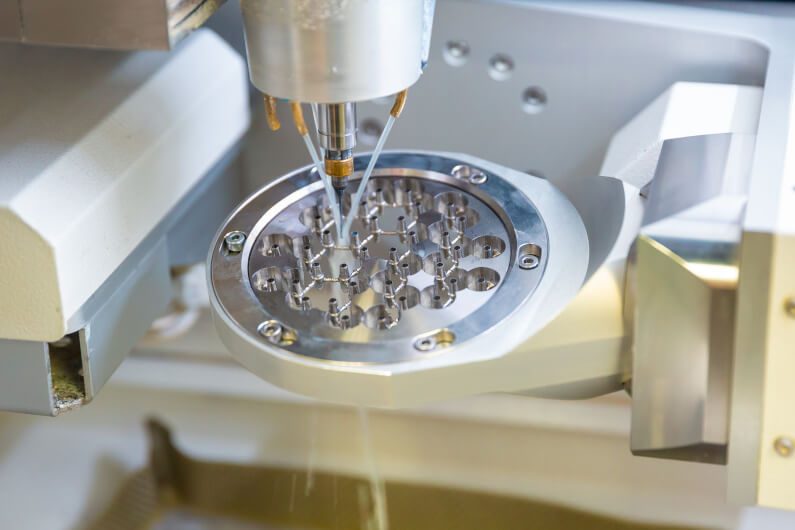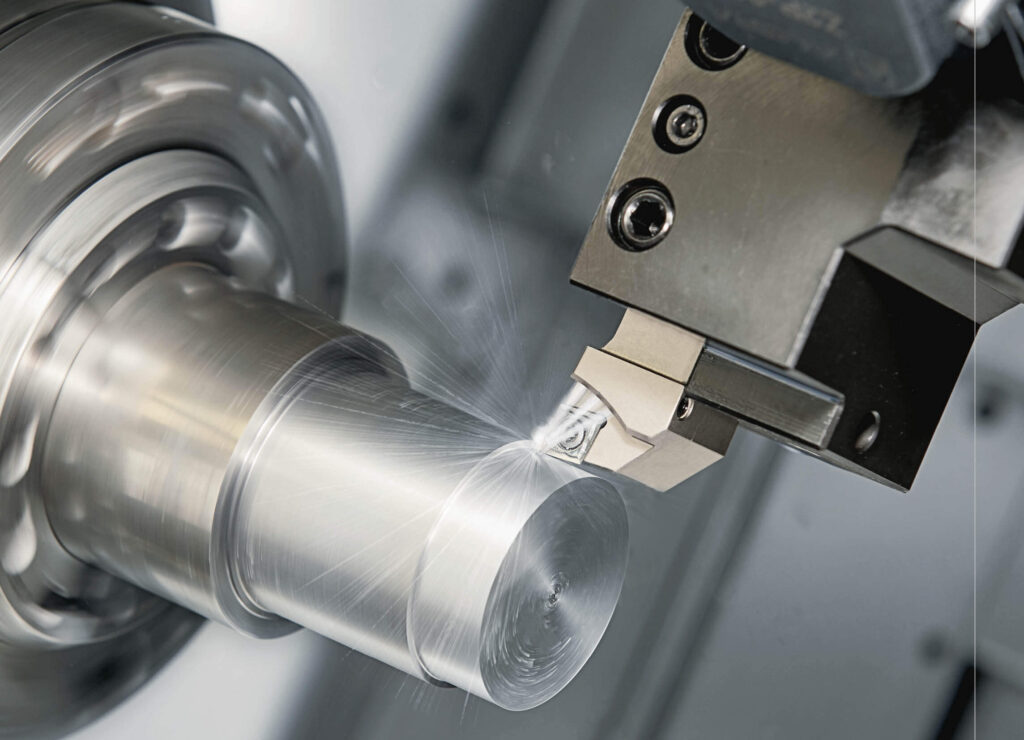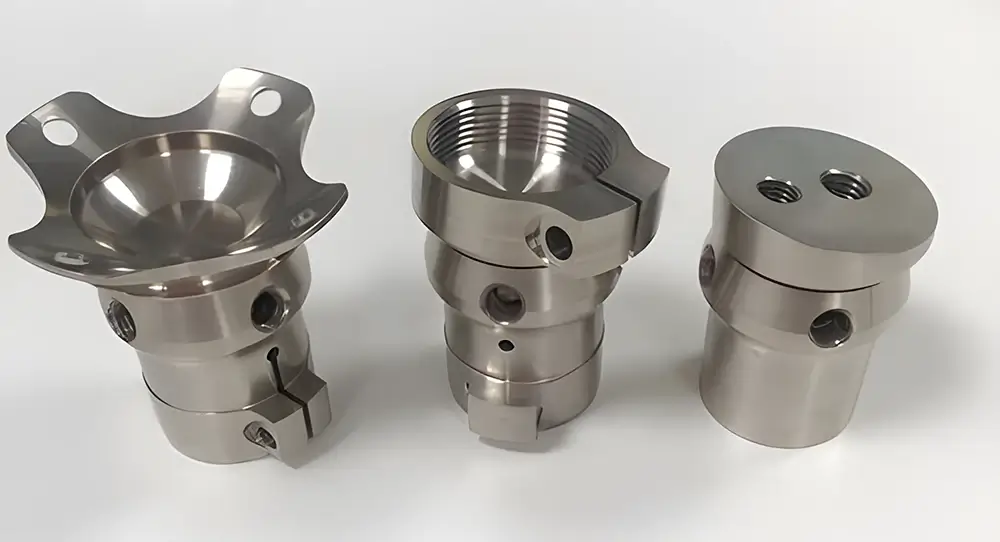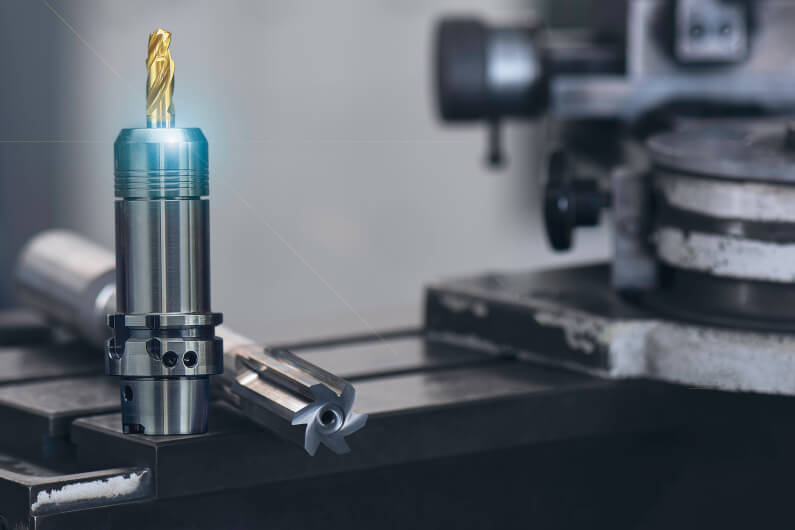Titanium Machining – Tips and Considerations
With its excellent strength-to-weight ratio and corrosion resistance, titanium is one of the most commonly used and popular metals by industrial engineers, architects, and consumer product designers. Titanium was named after the Titans of ancient Greek mythology, and it often lives up to its name.
Titanium has desirable material properties, and it’s also relatively easy to machine. Titanium can be welded (in an inert atmosphere) and can be CNC machined just like stainless steel.
It also lends itself to nearly every surface treatment: sandblasting, powder coating, and electrophoresis all produce good results when applied to titanium. Of course, there are metals that are more machinable than titanium, but titanium has good formability and mechanical properties.
That being said, designing and manufacturing titanium parts isn’t always the same as aluminum parts or parts made from lower-cost materials. Since titanium billets cost about 10 times more than 6061 aluminum, you want to make sure you get your parts done right the first time.
This post discusses the basics of titanium machining, including the most appropriate applications, machining considerations, and surface finish options.
1.What is titanium?
Titanium is a lustrous transition metal that was discovered in England in the 18th century. It has a silvery appearance and is extremely strong despite its low density. This makes it a valuable commodity in industries where lightweighting is particularly important.
In addition to its good strength-to-weight ratio, titanium is highly resistant to corrosion (seawater, chlorine, and acids) and is not toxic even when used in large quantities.
This makes it particularly useful in the medical field, where it can be used in implants and other medical devices. In manufacturing, titanium is often alloyed with elements such as iron, aluminum, and vanadium.

2.Why Use Titanium?
Despite its high price, titanium is a very popular material.
Reasons for using titanium include:
- High strength
- Corrosion resistance
- Good strength-to-weight ratio
- Ductility
- Good machinability
- Surface treatment options
- Recyclable
For these reasons, titanium is often used in industries such as aerospace, automotive, and medical. Titanium aerospace CNC machining includes aircraft engine components, fuselage components, rotors, and compressor blades. In fact, aerospace drives titanium production: two-thirds of the titanium produced in the world is used in aircraft engines and fuselages.
In the medical field, titanium parts include surgical implants (such as long-term hip replacements) and instruments. The metal is also used to make items such as wheelchairs and crutches.

3.Why CNC Machine Titanium?
For the most accurate and affordable titanium parts, CNC machining is almost always the best manufacturing technology. To understand why, let’s look at the alternatives.
Manufacturers rarely cast titanium parts. This is because heated titanium reacts violently with oxygen, and many refractory materials used for casting contain trace amounts of oxygen.
One solution is to use stamped graphite casting—using oxygen-free graphite castings—but this produces parts with very rough surface textures and is unsuitable for most medical, aerospace, and industrial applications.
Titanium parts can also be made using lost wax casting, but this requires a vacuum chamber.
A newer option is to use additive manufacturing to make titanium parts. A few 3D printing technologies, such as selective laser melting (SLM), electron beam melting (EBM), and direct energy deposition (DED), can process titanium 3D printing materials.
However, these 3D printing systems are very expensive, and many industries have not yet certified 3D printed titanium for safety-critical end-use parts.
Compared to other methods, CNC machining is a precise, safe, versatile, and affordable way to manufacture titanium parts.

4.Considerations for titanium machining
Titanium is an excellent material for many applications, but it has its own unique characteristics that must be taken care of during CNC machining.
Considerations for titanium machining include:
1) Heat Buildup
Titanium alloys are harder than common CNC machining and milling materials, such as aluminum alloys. This results in increased tool wear and increased heat buildup at the contact point.
For these harder titanium alloys, it may be necessary to reduce the speed of the CNC machine while using a larger chip load. High-pressure coolant can also reduce the burden on the cutting tool and help produce higher-quality titanium alloy parts.
Some commercially pure titanium (grades 1-2) may be less prone to excessive heat generation, but precautions should still be taken.
2) Galling
Compared to titanium alloys, industrial pure titanium has more prominent problems with undercutting and built-up edge. Grade 1-2 titanium alloys may become sticky during machining and eventually stick to the cutting tool. However, this can be alleviated by using high-pressure coolant and ensuring rapid chip evacuation.
If this problem is not addressed, it will also exacerbate the problem of heat buildup and accelerate the dulling of the cutting tool.
3) Workholding
Titanium and its machinable alloys are not as rigid as other common metals, so they need to be held tightly during CNC machining.
In addition to a rigid machine setup, it is also beneficial to maintain constant tool movement without interrupting the cut.

5.Surface treatment after titanium machining
CNC machined titanium parts can be improved with a variety of surface treatments for functional or aesthetic purposes.
Surface treatments include:
- Smoothing
- Polishing
- Sandblasting
- Brushing
- Painting
- Chrome plating
- Metallization
- PVD coating
- Powder coating
- Electrophoresis
6.Common titanium alloy grades
| Grade | Type | Typical Application Scenarios | Core Performance Characteristics | Key CNC Machining Considerations |
| TA2 | Commercially Pure Titanium | Chemical equipment, medical devices, light industrial parts | Excellent corrosion resistance, good plasticity, low machining difficulty | – Tools: Carbide or high-speed steel- Cutting speed: 50–80 m/min- Cooling: Regular cutting fluid sufficient |
| TC4 | α+β Titanium Alloy | Aerospace structural components, automotive parts, medical devices | Best overall performance (strength, toughness, corrosion resistance) | – Tools: Ceramic or CBN (Cubic Boron Nitride)- Cutting speed: 60–100 m/min- Cooling: High-pressure cutting fluid to prevent adhesion |
| TA1 | Commercially Pure Titanium | Low-strength corrosion-resistant scenarios (e.g., heat exchangers, vessels) | Highest purity (Ti≥99.5%), optimal machinability | – Can use high-speed steel tools- Feed rate: 0.1–0.3 mm/r- Avoid low-speed adhesion |
| TA15 | α Titanium Alloy | High-temperature components in aircraft engines (e.g., compressor blades) | High elevated-temperature strength (≤500°C), good weldability | – Tools: Coated carbide (e.g., TiAlN)- Cutting speed: 30–50 m/min- High-rigidity fixtures to prevent deformation |
| TB6 | β Titanium Alloy | High-strength structural components (e.g., aerospace fasteners, landing gear) | Extremely high strength after heat treatment (≥1300 MPa), easy hot forming | – Tools: PCD (Polycrystalline Diamond) or ceramic- Cutting speed: 100–150 m/min- Segmented cutting to prevent overheating |
If you are looking for an experienced machining manufacturer, Xavier is your ideal choice. The Xavier team is well-equipped to provide high-quality machining solutions. If you need more information or to discuss your machining needs with us, please feel free to contact us.
